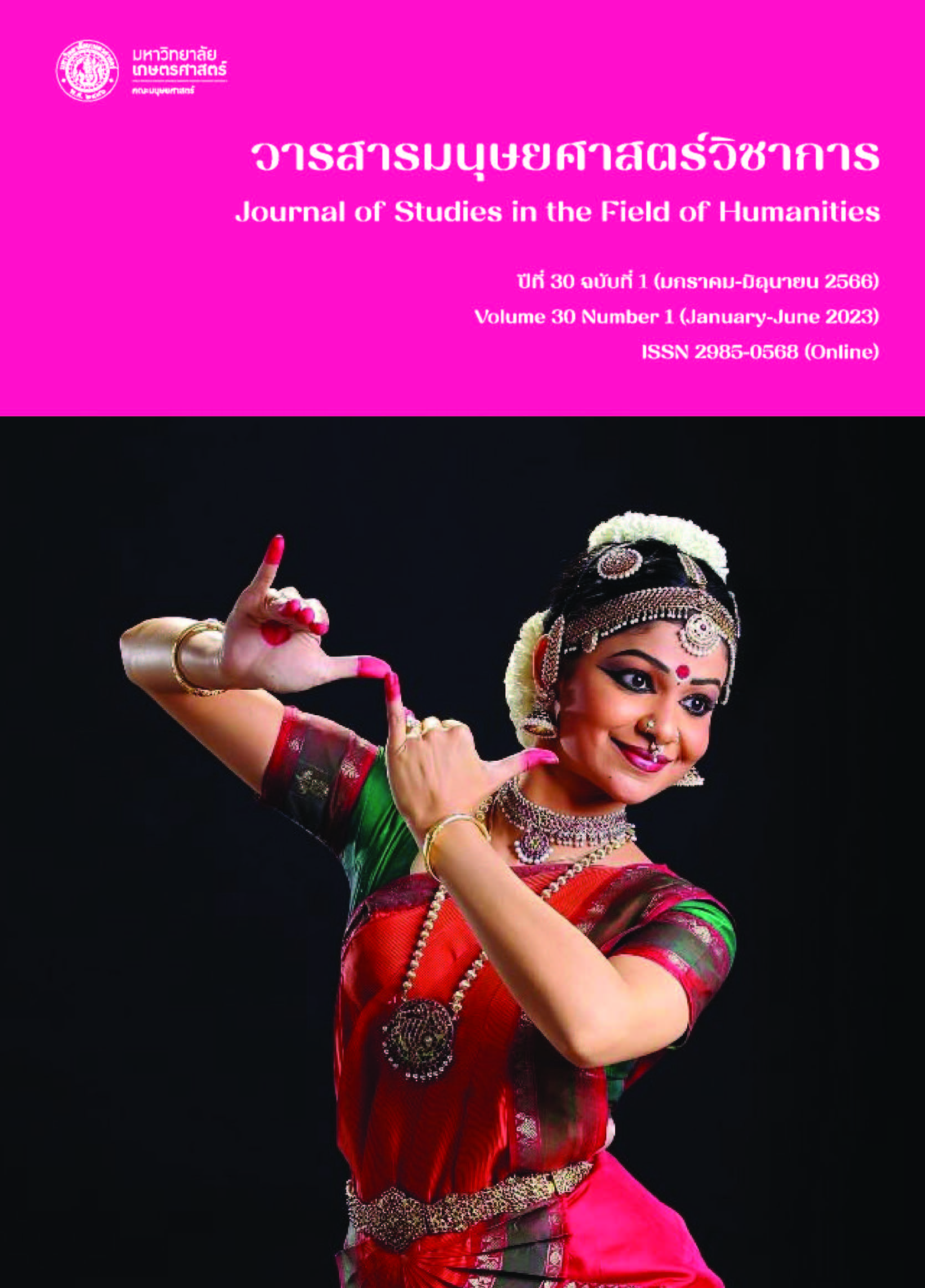Adaptation Process and Meaningful Representation of Hindu Sculptures in Bangkok
Main Article Content
Abstract
This qualitative research aimed to study sculptures that present the meaning of Hinduism in Bangkok. The information was gathered by the qualitative method which consisted of interviews, observation, and documentation. The research found that the characteristics of the iconography of Gods and beliefs were different depending on the popularity of each location. For instance, Indian art was one style and Thai art was another style. Therefore, sculptures of Gods were different even when they were from beliefs that originated from the same location. From studying 7 sculptures which were Ganesh, Shiva, Parvati, Vishnu, Lakshmi, Brahma, Saraswati built in Bangkok, the research found that some of them were built in the Indian style found in Hindu places in Bangkok while some of them were not. Semiologically, it was found that the sculptures of Gods of Hinduism hold various things; therefore, they were built with multiple hands. This represented the characteristics of each God which was the symbol that had meanings inside. There are three general principles of the symbol in the sculptures of Gods: 1) weapon to fight against bad things; 2) flower, tree, and seedling representing fertility; and 3) things signifying priesthood such as a string of beads, a scripture, and a kettle (kalasha).
Article Details

This work is licensed under a Creative Commons Attribution-NonCommercial-NoDerivatives 4.0 International License.
References
กฤติยา วโรดม. (2560). ปัจจัยเสริมสร้างการบูชาเทพฮินดูอย่างสัมมาทิฏฐิในสังคมไทย. วารสารสันติศึกษาปริทรรศน์ มจร., 5(3), 160-171.
คมกฤช อุ่ยเต็กเค่ง. (2564, 19 มีนาคม). ผู้ช่วยศาสตราจารย์ประจำคณะอักษรศาสตร์ มหาวิทยาลัยศิลปากร จังหวัดนครปฐม. [บทสัมภาษณ์].
เชษฐ์ ติงสัญชลี. (2559). ประติมากรรมฮินดู-พุทธในศิลปะอินเดียกับคัมภีร์ศิลปศาสตร์ภาษาสันสกฤต. กรุงเทพฯ: เรือนแก้วการพิมพ์.
เชษฐ์ ติงสัญชลี. (2564, 5 มีนาคม). ศาสตราจารย์ประจำคณะโบราณคดี มหาวิทยาลัยศิลปากร กรุงเทพฯ. [บทสัมภาษณ์].
ฐิรวุฒิ เสนาคำ, บรรณาธิการ. (2549). เหลียวหน้าแลหลัง วัฒนธรรมป๊อป. กรุงเทพฯ: ศูนย์มานุษยวิทยาสิรินธร (องค์การมหาชน).
นงคราญ สุขสม. (2561). ถอดรหัสพระเจ้าฮินดู. กรุงเทพฯ: พระรามครีเอชั่น.
นฤพนธ์ ด้วงวิเศษ. (2558). “ความต่าง” ของ “วิธีคิด” ต่อวัฒนธรรมกระแสนิยม. สืบค้นเมื่อ 4 กุมภาพันธ์ 2564 จาก ttps://www.sac.or.th/databases/anthropology-concepts/articles/7.
เนื้ออ่อน ขรัวทองเขียว. (2564, 12 มีนาคม). รองศาสตราจารย์ประจำคณะมนุษยศาสตร์และสังคมศาสตร์ มหาวิทยาลัยสวนดุสิต กรุงเทพฯ. [บทสัมภาษณ์].
พระธรรมธรชัยสิทธิ์ ชยธมฺโม (ศรชัย). (2560). การบูชาวัตถุมงคลเพื่อส่งเสริมพฤติกรรมดีในทางพระพุทธศาสนาของประชาชนอำเภอนางรอง จังหวัดบุรีรัมย์ (วิทยานิพนธ์มหาบัณฑิต สาขาวิชาพระพุทธศาสนา). มหาวิทยาลัยมหาจุฬาลงกรณราชวิทยาลัย, กรุงเทพฯ.
ราชันย์ เวียงเพิ่ม. (2550). พระคเณศ: ตำนานและพิธีกรรมในสังคมไทย (วิทยานิพนธ์มหาบัณฑิต สาขาวิชาภาษาไทย). จุฬาลงกรณ์มหาวิทยาลัย, กรุงเทพฯ.
สุกัญญา ประเสริฐศรี. (2551). เทศกาลนวราตรีวัดพระศรีมหาอุมาเทวี: การศึกษาพิธีกรรมและความเชื่อ (วิทยานิพนธ์มหาบัณฑิต สาขาวิชาภาษาไทย). มหาวิทยาลัยศรีนครินทรวิโรฒ, กรุงเทพฯ.
สุภางค์ จันทวานิช. (2559). ทฤษฎีสังคมวิทยา (พิมพ์ครั้งที่ 7). กรุงเทพฯ: จุฬาลงกรณ์มหาวิทยาลัย.
สุรชัยภัทรดิษฐ์ หลอดคำวัฒนา. (2554). พระพิฆเนศ: การผสมกลมกลืนรูปแบบประติมากรรม ความเชื่อ ประเพณี พิธีกรรมในสังคมไทย (วิทยานิพนธ์ดุษฎีบัณฑิต สาขาวิชาวัฒนธรรมศาสตร์). มหาวิทยาลัยมหาสารคาม, มหาสารคาม.
อรุณศักดิ์ กิ่งมณี. (2540). “เทวะประติมาน” ในงานจิตรกรรม: ศึกษาเฉพาะกรณีเทพผู้พิทักษ์อุโบสถและวิหารสมัยรัตนโกสินทร์ (วิทยานิพนธ์มหาบัณฑิต สาขาวิชาประวัติศาสตร์ศิลปะ). มหาวิทยาลัยศิลปากร, กรุงเทพฯ.
เอกสุดา สิงห์ลำพอง. (2553). เทวปฏิมาสยาม. นนทบุรี: มิวเซียมเพรส.
Fontana, A., & Frey, J. H. (2003). The interview: From structured questions to negotiated text. In N. K. Denzin & Y. S. Lincoln (Eds.) Collecting and interpreting qualitative materials. London: Sage Publications.
Healey, J. F. (1996). Statistics: A tool for social research (4th ed.). California: Wadsworth Publishing.
Smith, T. M. F. (1993). Populations and Selection: Limitations of Statistics (Presidential address). Journal of the Royal Statistical Society, 156(2), 144-166.


